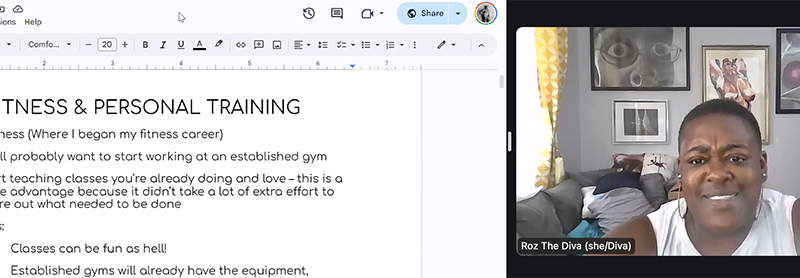[memberonly level=“Group Membership for Businesses of 2-5 individuals, Student, Individual or Solo-Preneur”] Please note that…

Business Plan Template
All businesses start in the fundamentally same way: figuring out what you’re doing and why you’re doing it. Begin this conversation with yourself and your trusted support system such as a spouse or friends, formally or informally answering those questions. You can use a formal process like a SWOT analysis to assist you in answering those questions or just chat more informally.
A business plan for your business comes after you’ve decided to start a business. It is a formal, written document that specifies your business goals and how to achieve those goals. If done correctly, a business plan is a great roadmap for your business. While you do not need a business plan to start a business, it can help organize your thoughts. If you do not self-fund your business but try for loans or grants, many organizations may want a documented business plan to review. Even if you’re not pitching people to give you money, grants or loans, a business plan may be required by commercial landlords if you are looking for space and at a minimum, having this document is a great way to organize your thoughts.
There is a lot of research and strategic guesswork that goes into every business plan. Fortunately there are tons of online resources that can help you research your market, your customers, your competitors and a whole host of other things from the comfort of your smart device.
Always keep your audience in mind and understand the purpose of the document. If this document is just for you, you might want to be more honest with things like your objectives. If your audience is a grant organization, you might see how you can tie in your mission with theirs to have a better shot at being funded. You could have several different versions of your business plan, all tweaked to slightly different audiences or with adding or deleting certain sections. If you’ve already been in business a while and never had a formal business plan, consider doing this exercise to help you organize your thoughts and goals as you move to the 2.0 version of your business. This might also be a useful exercise to use as you grow and add new lines of business or new locations.
1.0 Executive Summary
Give your audience a one-page or less summary of what you want to do and what will make you successful (personal connections, great market, concept was successful somewhere else, etc.) Use a graphic!
1.1 Objectives
List up to three objectives, can be personal but consider your audience – do they care that you want to leave your day job? Or do they care more about providing fitness options for underprivileged youth?
1.2 Mission
Your mission statement, can be a run on sentence but try to overall keep it simple. What do you want to do and who do you want to serve? Ultimately, what is written on your business tomb stone: “Hear lies Llama Farms, LLC they bread show quality llamas at a fraction of the price, providing wool to only the finest spinners.”
1.3 Keys to Success
Expand on what you put in your executive summary – what do you have personally, in the market or otherwise that will actually make this succeed. You’re looking into your crystal ball here.
2.0 Company Summary
One line summary of the company – are you a home-based business run by Sally? Or are you a major manufacturer with 5,000 employees?
2.1 Company Ownership
Who owns the company? What is your business structure? LLC, Inc., franchise, etc.
2.2 Company History (for ongoing companies) or Start-up Plan (for new companies)
Are you buying an existing business or buying into a franchise? Are you copying an existing business? When did you get the idea?
2.3 Company Locations and Facilities
Your location and initial facilities needs either current or expected. If expected, do some research to see what’s available in your area, $22/sq ft 1,000 sq ft first level retail available in 3 months in viable commercial corridor, etc.
3.0 Products and Services
In one sentence – what do you sell? I.e., we sell the highest quality candles made out of West Kentucky sourced bees, known for their unusual and pleasing scent.
3.1 Product and Service Description
Do you just sell candles? What kind of candle product likes do you have? Be detailed.
3.2 Competitive Comparison
Research your competition or state that you have none.
3.3 Sales Literature
Provide sample mock-ups of basic sales/marketing material including: website, social media pages, logo, business card, brochures, etc. Provide reasons why you are choosing certain colors and styles, research!
3.4 Sourcing and Fulfillment
If you are staff based – where do you get your staff? Is it an organizational chart with Sally in every position from janitor to CEO? Are you sourcing talent through consultants? An off shore facility? How will you staff your product/service needs? Is everyone taking meetings in your kitchen or are you baking pies half time out of your day-job’s commercial oven?
3.5 Technology
What do you need to get started? Is a laptop and internet connection enough? Or do you need a 3D printer? Be specific and get actual quotes. Research!
3.6 Future Products and Services
What else might you offer? What is a logical extension from llama farming? Training others to llama farm? Llama merchandise?
4.0 Market Analysis Summary
Is there an existing market for your services/product? Research the existing market and understand how and why you fit into it. You want to have a food truck – cool! Explain why there are tons of food trucks, explain how you’re different. Give some facts and figures about the market (search online for this info)
4.1 Market Segmentation
Using the example in 4.0 — within the restaurant market, food trucks are a segment of that market. You could further explain how gyros are a subset of that. Is there growth in the lunch market for gyro-based food trucks in your major city? Use the internet to help you research.
4.2 Target Market Segment Strategy
Who are your customers? People just looking for convenient lunch options? If so, location is an issue. What is your price point and how will that attract the people you want to buy your food? Are you going to advertise to them? How? What newspapers do they read? What websites do they visit? Are they social media savvy? Understand who you want to sell to.
4.2.1 Market Needs
Think about how you fit in the market. Is there room for you? Or are you going to make room? Can you serve a niche that isn’t being filled?
4.2.2 Market Trends
Explain how food trucks have been growing since year XXXX. Explain what the “experts” think is the trajectory. Who seems to do the best? Traditional food or unique? Is marketing a factor or is it flavor? What about price? Research!
4.2.3 Market Growth
Are there specific things coming in the future that will grow or inhibit the market? Is there legislation in your city against food trucks? What about taxation? What limits people from entering the market? Is there a top end to the market? Do you have a fleet of trucks or eventually your own physical restaurant.
4.3 Industry Analysis
Think big and small. What is your industry like?
4.3.1 Industry Participants
Who are the major participates in the market? These could be customers, partners, vendors and competitors.
4.3.2 Distribution Patterns
Is there a specific geography that is better served by food trucks? Would you be as successful on Street X and not Street Y?
4.3.3 Competition and Buying Patterns
Research everything about your competitors. Go to their website, stalk their food trucks, try their food, ask their customers what they like and don’t like. You can do this all by yourself or you can hire companies to help you do market research. The internet is a wealth of stalk-able information. Track everything and see where you are the same and where you are different.
4.3.4 Main Competitors
After following some food trucks around, find the ones that are most like you or that you could be a big threat to. See if you can partner. Maybe they’re selling grape leaves and you’re selling gyros. People might want both – perhaps you can sell together on the same street, or offer a discount to buy at both. Competitor doesn’t mean “evil arch-nemesis” – find a way to be win-win. If you’re the little guy and they have 400K+ likes on Facebook, find a way to imitate them. Try not to copy exactly but do see what they do. Are they posting on Instagram three times a day? Then you should too.
Strategy and Implementation Summary
Describe your strategy and how you are going to implement. Are you going to rely heavily on digital marketing like Facebook or you going to rely on direct mail?
5.1 Strategy Pyramids
A strategy pyramid involves three levels – the strategy is at the top, then under it are the tactics, the specific type of things you are going to do and finally the programs at the bottom—exactly what you’re going to do.
5.2 Value Proposition
Why should clients work with you?
5.3 Competitive Edge
Elaborate on your competition value proposition—what specifically makes you different from your competition.
5.4 Marketing Strategy
How are you going to market your product or service? Refer to your pyramid. Consider creating a full marketing plan.
5.4.1 Positioning Statements
Think about how you are going to talk to different audiences about your product or service.
5.4.2 Pricing Strategy
What is your pricing strategy? Are you selling by the piece? By the hour? How are you determining your price? Are you adding all your costs together? And allowing yourself to make a profit?
5.4.3 Promotion Strategy
Outline what your promotion strategy is going to be. Be specific. Focus on specific dates, is there a big convention you’re going to promote at? Are you doing daily or weekly promotions through social media?
5.5 Sales Strategy
This dovetails with your marketing strategy. Are you going to do direct sales? Are you selling online? Do you have a licensing program for your intellectual property?
5.5.1 Sales Forecast
Using your best “crystal ball” – will you break even in the first month, in the first year? Be specific.
5.5.2 Sales Tracking
How are you going to track your sales? Are you using an online tool or a simple spreadsheet?
5.6 Strategic Alliances
Who can help you? Do you have complimentary services? Is there someone who can extend your sales or marketing reach? Perhaps offer a discount of your services to their customers. Make a list and then start reaching out.
6.0 Web Plan Summary
This is part of your marketing strategy. Your website is key to your branding and presence. There are many tools that you can use yourself or you can hire a designer. Check out Squarespace.com, Wix.com and WordPress for ideas to do this for a low cost.
6.1 Website Marketing Strategy
Other than your visual branding and words, start tracking your analytics and adding search engine optimization.
6.2 Development Requirements
Who is going to create your website? Who is going to maintain it? What is your go live schedule and your maintenance schedule? Do you need any specific tools?
7.0 Management Summary
Who manages your company?
7.1 Organizational Structure
What is your organizational structure? Are you doing everything or do you have people to help you? Are you built on volunteers or are you hiring paid consultants or vendor companies? Think through all the positions you’ll need including finance/accounting, legal, facilities, operations, sales, marketing, taxes and anything else you might need.
7.2 Management Team
You’re likely to be on the management team, but once you’ve thought through your organization, who is going to be your core help on the team. It’s ok if your cat occupies your “assistant” position.
7.3 Management Team Gaps
If your cat is your assistant, you might have some management team gaps.
7.4 Personnel Plan
When you’re writing your business plan it’s important to start thinking about growth. You might be small now, but to grow you’ll need more help. How will you hire them? When will you hire them? Are there special requirements or permits for having appropriate staff?
8.0 Financial Plan
This is the most important part of your plan. It is also the most sketchy. You’re going to have to do a lot of research and still have a lot of assumptions.
8.1 Important Assumptions
Assumptions are your best guess and best understanding of the market. It is important to research and find as many facts about your potential customers as possible. If you have any information from people in the industry such as their growth in the market in the recent years, that should be part of your assumptions about how your business could fair.
8.2 Key Financial Indicators
Thinking about your growth, at what growth levels do you start to hire staff? Or get out of your basement? Or close your business? Be honest with yourself.
8.3 Break-even Analysis
Start working on your budget. Outline all the costs to start up your business. Don’t forget to include your own time. Then figure out using the pricing strategy, how many units do you have to sell before you break even for your initial investment?
8.4 Projected Profit and Loss
Beyond your initial investment, what is your estimated profit and loss for the first year? You are using a lot of crystal ball guessing here and try to guess both high and low; best case and worst case scenario.
8.5 Projected Cash Flow
Budgets are one thing, but cash flow is something else. If you have a business that isn’t paid for 90 days after invoice receipt, you’re gonna have some cash flow issues. If you have a business that is point of sale but you need a large up front investment or regular payroll, then you’re gonna have cash flow issues. Project your best and worst case scenarios.
9.0 Long-term Plan
Where do you want to be in 1 year, in 3 years, in 5 years? Think big!
10.0 Immediate Actions to be Taken
It’s helpful to list immediately what you have to do next. Be specific with your actions, timeline and who is going to do the task.
Conclusion
Congrats! You’ve now done all the hard work to get your business plan in order. You can constantly update this document and use it as a blue print to see where you are going next. This can be a very useful document to help you get funding through investors or grants or just to organize your thoughts.



